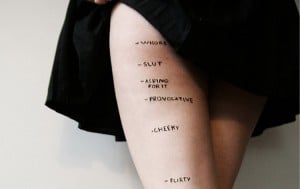
Source: Rosea Posey
Originally published on Beauty Redefined and cross-posted here with permission. Image credit: Rosea Posey.
Women and girls are more than just bodies. But you wouldn’t know that if you looked to media, or even sometimes well-meaning religious rhetoric, for the truth about females. And you wouldn’t know that if you listened to the way so many of us discuss the topic of appropriate dress, or “modesty,” today.
We are growing up and growing older surrounded by profit-driven media’s fixation on bodies – from “Perfect Your Parts, Perfect Your Life!” billboards to always-Photoshopped magazines and TV obsessed with judging what women wear and how much cellulite they have.
In an inescapable media world that pans up and down women’s bodies and focuses so much attention on their parts, no wonder girls learn to display their bodies as something to be looked at. No wonder girls learn to survey their bodies at all times, and in all things they are wearing, and in all places they are going.
Today in many circles, issues of female “modesty” are very popular. From many religions’ focus on appropriate dress to schools having rules on how high above the knee girls’ shorts can and can’t be or how much bare shoulder is too much – modesty is a trending topic.
Fashion boutiques have names like “Sexy Modest” and “Modest is Hottest!” is a popular phrase endorsing full-coverage clothing. While reasons for suggesting modesty vary greatly, we at Beauty Redefined can attest that far too much emphasis is being placed on arbitrary standards that are harming females from a very young age and keeping us fixated on females as bodies alone.
From a research-driven point of view, there is power in modesty. Many cultures and religions echo that sentiment to varying degrees — that covering up your parts is crucial to respecting bodies, which are viewed as sacred.
Regardless of your spiritual orientation, an open discussion about modesty from the perspective of our research can get us somewhere much more powerful and valuable than the shallow “modest is hottest” mentality so prevalent today.
Here’s the truth you can stand behind:

We are more than bodies to be looked at. Self-objectification is an epidemic among females today, as Lexie’s PhD research can attest, and it keeps females “in their place” as bodies in need of constant preoccupation and perfection. It takes place when we internalize an outsider’s perspective of ourselves.
We literally picture ourselves being looked at as we go throughout our days, and research shows it gets in the way of everything we do. Everything. When we have to accomplish a task while also thinking about what we look like while doing it, we’re at a major disadvantage.
When we live “to be looked at,” self-conscious of our bodies, we are left with fewer mental and physical resources to do what can really bring happiness. We perform worse on math tests, logical reasoning tests, athletic performance, we have lower sexual assertiveness (including the ability to say “no” when needed), and we are left unfulfilled and unhappy.
When we self-objectify, which is the norm today for little girls all the way up to older women, disordered eating and cosmetic surgery procedures increase, we stop raising our hands in class, and we quit pursuits of math and science degrees at greater rates.
We experience immense body shame, anxiety and depression, and fixate on our bodies enough that we never get on to the great things we can and should be doing.* Girls and women LOSE — and so do the men all around us — when we fixate on bodies.
Many discussions of modesty, from diverse cultural or religious perspectives, revolve around the idea of keeping sinful and unholy female bodies and body parts from the gaze of others — particularly men.
This privileges the male gaze, in a backward sort of way, and puts females at a disadvantage for being the ones in control of what others think or feel when seeing their bodies.
When we speak of modesty strictly in terms of covering our bodies from the sexual gaze of others, we are keeping the level of discourse at the shallow waters of women and girls as bodies alone.
We have very little control of what other people think when they look at us. If we are teaching the girls in our lives that the primary objective of modesty is to keep themselves covered so boys and men don’t think sexual thoughts about them, then we are teaching girls they are responsible for other peoples’ thoughts and they are primarily sexual objects in need of covering.
No girl or woman’s body is sinful, and no one should be taught that. Modesty, as an ideal, can be about so much more than shaming females into covering up.
Modesty can be a powerful concept when we believe we are more than bodies. And when you believe you are more than a body – that you are capable of more than being looked at and you can do more than work on perfecting your parts – then you might dress differently than someone who perceives her value comes from her appearance, or the amount of attention she gets from men.
Someone who sees herself as a capable and powerful person with a body that can help her achieve great things might act differently than someone who exists solely to look “hot.” She’ll treat her body differently and think about it differently.
If you believe your power comes from your words, your unique contributions, your mind, your service, then you don’t need to seek attention and power by emphasizing your parts and minimizing yourself to your body.
If modesty is a concept you subscribe to, there is great power in changing the modesty conversation from what you LOOK like to others to what you FEEL like inside.
Studies on the epidemic of self-objectification show us that “clothing represents an important contributor to the body and emotional experience of contemporary young women” because body-bearing clothing leads to greater states of self-objectification, body shame, body dissatisfaction, and negative mood (the latest study of this kind was just published in May 2012’s Sex Roles academic journal).
What this tells us (and what our own experience living in female bodies tells us is a no-brainer) is that when we wear clothing that is revealing or emphasizing our parts, we become very self-aware of those parts that are being looked at.
We self-objectify and are in a near-constant state of adjusting our clothing, fixating on what we look like, and looking at other people looking at us.
It’s OK to like being looked at, and even to like attention from others for our looks, but if it’s getting in the way of progress, happiness, and health — as so much research confirms that it is — we’ve got to move on to being more than an object to be looked at.
Research shows a level of modesty can be an important tool in safe-guarding ourselves and our daughters from being in a constant state of self-objectification.
 We see why suggestions regarding the length of hemlines and the depth of necklines are important because we live in a sexual world where even the youngest of girls are sexualized to an extreme degree and they are told their “sexiness” will bring them popularity, love, and happiness.
We see why suggestions regarding the length of hemlines and the depth of necklines are important because we live in a sexual world where even the youngest of girls are sexualized to an extreme degree and they are told their “sexiness” will bring them popularity, love, and happiness.
Studies show girls as young as 6 years old are sexualizing themselves because media messages show them being sexy yields rewards (a July 2012 study in Sex Roles reveals the latest).
As we‘ve written about before, even girls’ TOYS and cartoon characters are sexualized to the extreme these days. But when we fixate on the inches showing we are missing the point.
When we judge girls and women for the skin they are or are not showing, we are minimizing them to their bodies and repeating the same lies that females are only bodies in need of judgment and fixing. We are even perpetuating the shame-inducing belief that female bodies are sinful and impure, and must be covered to protect boys and men who can’t be held responsible for their thoughts or actions.
Modesty is defined differently by different cultures – even different families – and it’s time to stop shaming people into covering themselves and start teaching truths that need shouted from the rooftop: We are capable of much more than being looked at! We are more than bodies.
When we begin believing that, we begin acting like it, and female progress in every imaginable way will move forward.
We will spend less money on cosmetic surgery (up 500% in the last decade with 92% of the surgeries performed on women) and every other product we need to “fix” our flaws.
We will spend less time minimizing and obsessing over our insecurities beneath our clothes. We will spend less time emphasizing and obsessing over our favorite parts on display in our clothes.
We will perform better academically, athletically, and in our careers. We will love other women more because we will not be judging them as bodies.
We will feel greater self-love, happiness, and power to live authentically chosen lives. We will pass along all of these powerful truths to the little girls growing up in an increasingly sexualized world.
[do_widget id=”text-101″]
*For a comprehensive list of self-objectification’s many negative consequences, see the American Psychological Association’s Task Force on the Sexualization of Girls.
Lexie Kite co-founded The Beauty Redefined Foundation in 2009 with her twin sister, Lindsay Kite, based on their master’s and Ph.D. research in Communications. She has a passion for helping women recognize and reject harmful messages about their bodies and what beauty means and looks like. Lindsay have been featured on Al Jazeera English TV, the Huffington Post, iVillage, KSL’s Studio 5, Fox13 News, KUTV2 News, the Deseret News, the Salt Lake Tribune, and many more.
Search our 3000+ articles!
Read our articles about:
Our online racial justice training
Used by hundreds of universities, non-profits, and businesses.
Click to learn more




















